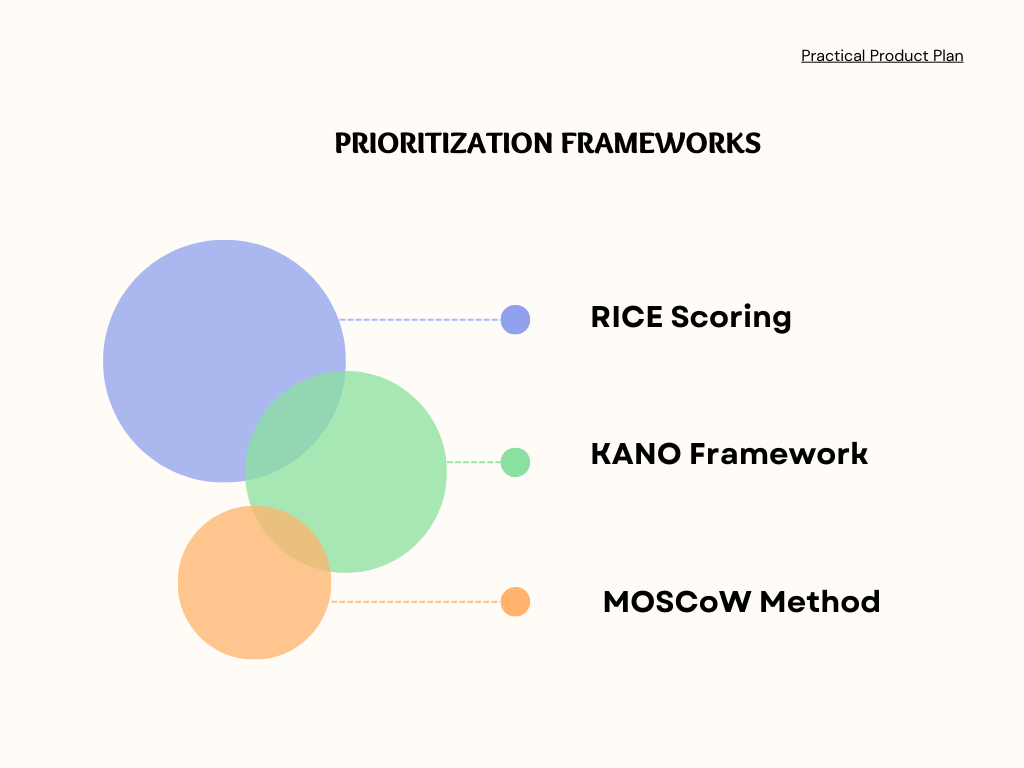Prioritization frameworks help companies determine which tasks or features to prioritize within a project and allow organizations to focus their efforts, resources, and attention on what matters most for greater efficiency and success.
Today, we’ll discuss about:
Why prioritizing is important
Types of Prioritization Frameworks
RICE Scoring
KANO Framework
MoSCoW Method
Why prioritizing is important in product development?
Helps allocate limited resources (such as time, budget, and manpower) effectively and efficiently.
Teams work on tasks or projects aligned with strategic objectives and goals.
Address high-risk items early in a project.
By focusing on high-priority tasks, people can reduce distractions and increase productivity.
Prioritization leads to the development of products and services that better meet customer expectations.
Prevents unnecessary spending on low-priority projects or features.
Helps in communicating with stakeholders, setting expectations, and managing their demands. It fosters transparency and trust.
Allows organizations to adapt to changing circumstances, emerging opportunities, and unexpected challenges.
Provides a framework for making informed decisions.
RICE Scoring Framework:
It's a method for ranking and prioritizing ideas, features, or projects based on their potential impact and feasibility.
Reach: This metric measures how many users or customers the task or initiative will impact. Determine the number of users who will directly benefit from it. Assign a numerical value to represent the potential reach.
Impact: Impact measures the degree of positive change the task or initiative will bring about for users or the business. Assign a score (e.g., from 1 to 10) to gauge the impact, where 1 indicates low impact and 10 signifies high impact.
Confidence: Confidence assesses how sure you are about the estimations for reach and impact. Assign a percentage (from 0% to 100%) that represents your confidence in the numbers. Higher confidence should be reflected in a higher percentage.
Effort: Effort quantifies the amount of time, resources, and work required to complete the task or initiative. Use a relative scale (e.g., small, medium, large) or estimate it in hours or days.
RICE scores are calculated using a simple formula:
RICE Score = (Reach x Impact x Confidence) / Effort
Reach, Impact, and Effort are assigned numerical values, typically on a scale from 1 to 10, with 1 being low and 10 being high.
Confidence is expressed as a percentage, ranging from 1% to 100%.
The resulting RICE score provides a numerical value that helps prioritize projects or features. The higher the RICE score, the higher the priority.
KANO Framework:
Used to prioritize and classify features or attributes of a product based on their impact on customer satisfaction. It helps product teams understand how different features or elements of a product influence customer happiness.
Must-Haves (Basic): Features customers expect. No joy when present, but frustration when missing.
Satisfiers: Better performance leads to more satisfaction, but not having them doesn't upset customers.
Delighters: Surprise features that delight customers when present, but their absence doesn't bother them.
Indifferent: Features that don't impact satisfaction much; customers are indifferent.
Dissatisfiers: Features that, when present, make customers unhappy; their absence is neutral.
To apply the Kano Model, we often use questionnaires to gather customer feedback and opinions on various product attributes. The responses are then categorized into the five groups mentioned above.
MoSCoW Method:
This method provides a clear framework for stakeholders to communicate and agree upon the relative importance of various project elements.
Must-Have: Essential requirements that must be delivered in the current iteration or release.
Should-Have: Important features that are prioritized after Must-Have items are completed.
Could-Have: Desirable but not critical features that can be considered once Must-Have and Should-Have items are addressed.
Won't-Have: Features that are explicitly deprioritized for the current iteration or release.
When faced with choices, individuals and teams can rely on established criteria to select the best course of action. With whatever prioritization technique you use, regular review and adjustment of the feature priorities are required to ensure that the project stays aligned with stakeholders' needs and goals.
The actionable template with all the PM frameworks is going to be live next week! This will be available for downloading purposes.







